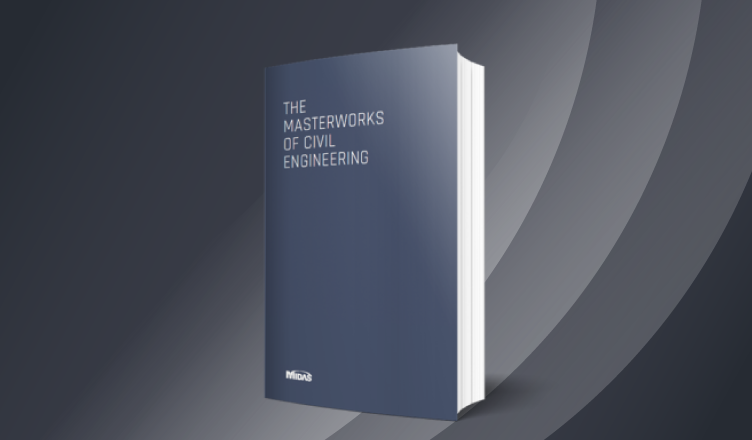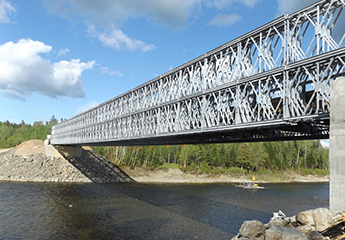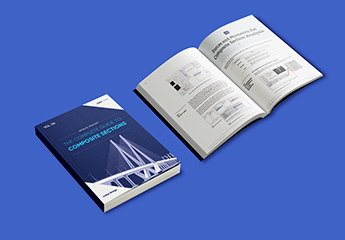Please fill out the Download Section (Click here) below the Comment Section to download the
download 80 Masterworks of Civil Engineering
Design with Prestress Tendon Profile in midas Civil
Table of Contents
1. Introduction
2. Types of Prestressing
3. Effect on Prestress Losses
4. How to Define Tendon Arrangement in midas Civil
5. Parametric Design Options
6. Conclusion
1. Introduction
Rapid construction of Bridges has become ease of improving the transportation infrastructure of a city. For the same, the PSC bridges, in which girders are fabricated off-site and then transported and erected into place at the job site, are becoming common. Pre-Stressed Concrete (PSC) pre-caste girders are particularly economical when longer beam lengths are required; some types are suitable for spans of up to 200 feet.
In this article, the methods of applying prestress and variables to satisfy the design demands have been mentioned with the use of midas Civil software solution. The program considers all the losses in tendons by simulating the sequence of prestressing with respect to time.
2. Types of Pre-Stressing
2.1 Post-Tensioned Elements
Post-tensioning is the method of stressing the tendons, after concrete is cast, and installed in their final location, to create enough lateral compression that the beam-unit will resist the desired amount of vertical loading. This is perhaps the most readily available method of prestressing objects. This method requires that the beam elements are cast with hollow tubes such that prestressing tendons can be installed and loaded in situ.
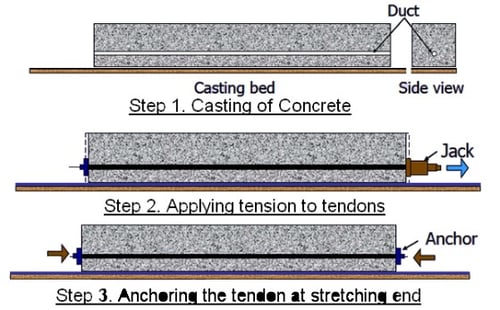 Figure 1. Stages of Post-Tensioning
Figure 1. Stages of Post-Tensioning
2.2 Pretensioned Elements
Pre-tensioning is the method of introducing high-strength steel tendons to the beam element, stressing them to a predetermined load, and then casting the concrete around them. Once the concrete has gained enough strength, the load is released from the steel tendons, thereby transferring this load to the concrete portion of the composite member. It is the relative loading of the strands before the concrete is cast that gives this method its name.
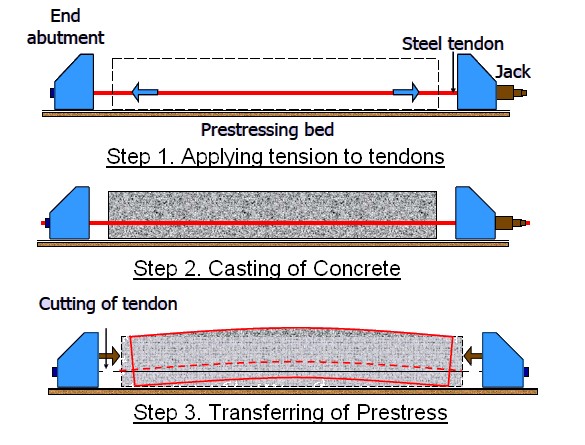 Figure 2. Stages of Pre-Tensioning
Figure 2. Stages of Pre-Tensioning2.3 External Elements
Pre-stress can be applied externally to girders. Midas Civil facilitates this method also for tensioning the elements.
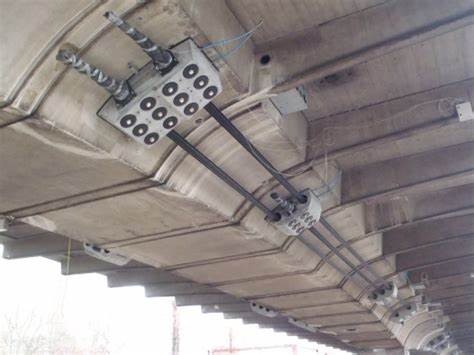 Figure 3. External Post-Tensioning of Box Girder
Figure 3. External Post-Tensioning of Box Girder
To meet the requirements of prestress in the girders, an Engineer has to decide the arrangement of tendon profile. In most cases, the tendon profile meets the demand of the flexural forces due to the permanent loads. The remainder loads are taken by the reinforcements in the cross section. In midas Civil, we can incorporate the stiffness of the cables and reinforcement in the overall analysis of the bridge.
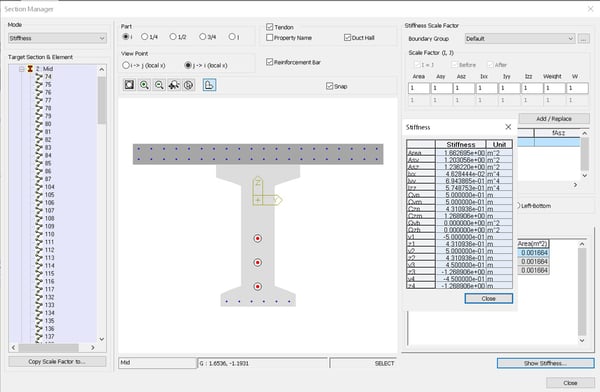 Figure 4. Section Manager in midas Civil > Stiffness
Figure 4. Section Manager in midas Civil > Stiffness
3. Effect on Prestress Losses
The instantaneous and time-dependent implications of the effects of prestressing steel must be understood and accounted for in the prestressed concrete girder design process.
Loss of prestress can be characterized as that due to instantaneous loss and time-dependent loss. Losses due to anchorage set, friction, and elastic shortening are instantaneous. Losses due to creep, shrinkage, and relaxation are time-dependent. Following variables affect the final stresses in tendons.
- Tendon property or tendon profile such as Curved, straight or harped.
- Consideration of Transformed Concrete Section
- Consideration of time-dependent properties of concrete
- Sequence of prestressing considered
- Prestressing force applied at one end or both ends
In midas Civil, we have complete control on these parameters. The section can be transformed based on the option selected under the Construction Stage Analysis Control.
4. How to Define Tendon Arrangement in midas Civil
Along with the wizards available in midas Civil to model PSC Bridges, there are several methods to incorporate the tendon arrangements. The tools provided are:
- Wizard
- Tendon Template
- Tendon Profile Generator
- Tendon Profile through Excel compatible coordinate table.
- MCT Command Shell
- Change Tendon Profile
4.1 Wizard
Pre-tensioned tendons can be defined using PSC Wizard under the Tendon tab as shown in Image 3. This is mostly used for preliminary analysis.
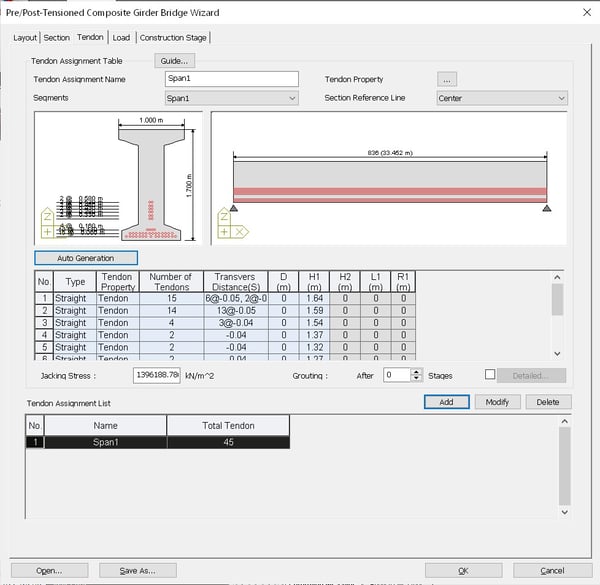 Figure 5. Tendon Profiles using Wizard
Figure 5. Tendon Profiles using Wizard
4.2 Tendon Template
Allows us to define preliminary tendon profile with a few input parameters. It is very useful when we define a tendon in several girder elements with the same profile. This tool can also be used to define a user-defined wizard.
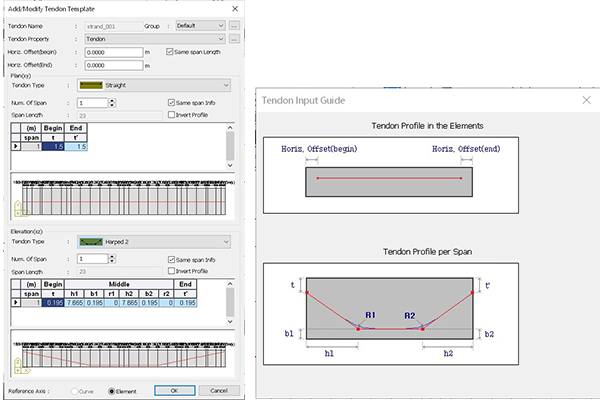 Figure 6. Tendon Template
Figure 6. Tendon Template
There are Code-based tendon templates based on standard precast sections to automatically generate tendons in elements. The Auto Generation function provides the tendon databases for the UK, USA, AS, NZ and Italian section types:
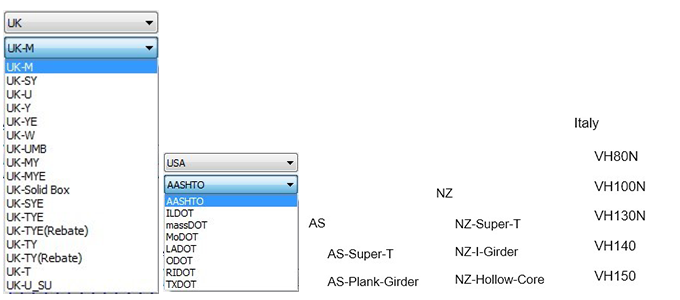 Figure 7. Standard Tendon Profiles
Figure 7. Standard Tendon Profiles
In case the database is not suitable for the standard sections of a country, region or precast sections manufacturing company, then the tendon template allows the export and import of the tendon profiles. Over 40 tendon profiles can be generated quickly for different spans of Bridges, which otherwise could be a major time-consuming process, especially for a preliminary analysis.
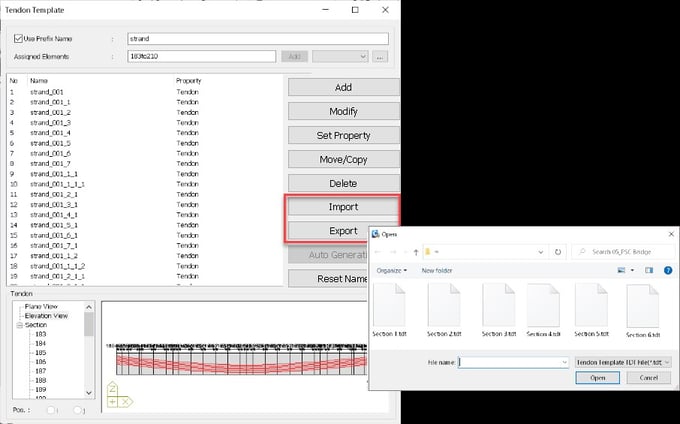 Figure 8. Import User Defined Tendon Profile
Figure 8. Import User Defined Tendon Profile
4.3 Tendon Profile Generator
Empowers the usage of AutoCAD DXF file to create tendon profile. Plan and elevation for the tendon to be imported is drawn separately in the DXF file.
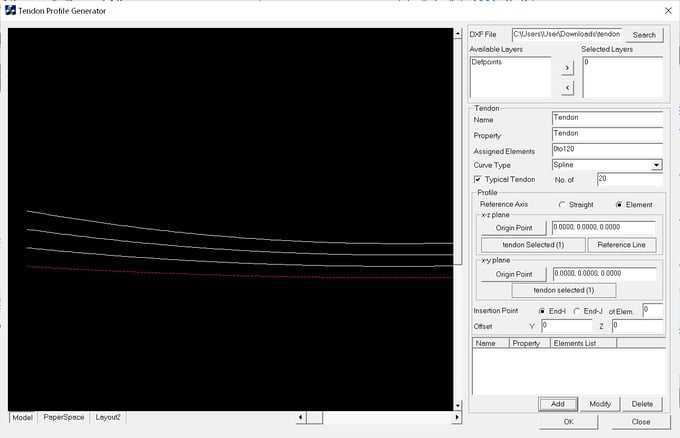 Figure 9. DXF Import of Tendon Profile
Figure 9. DXF Import of Tendon Profile4.4 Tendon Profile Through Excel Compatible Coordinate Table
We can copy the coordinates available in the excel file format and paste it in the definition of tendon profile as shown in the image below.
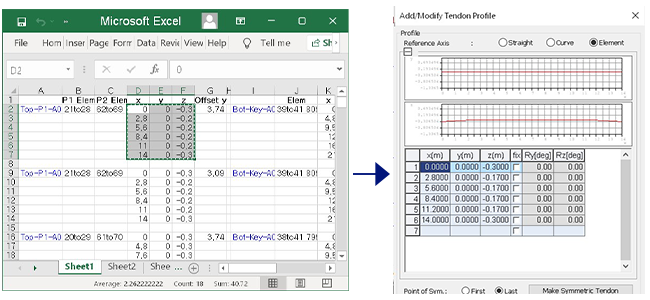 Figure 10. MS Excel Compatibility for Tendon Profile
Figure 10. MS Excel Compatibility for Tendon Profile
4.5 MCT Command Shell
A parametric analysis can be performed by simple modification using MCT command shell for each profile.
 Figure 11. To Change Tendon Property
Figure 11. To Change Tendon Property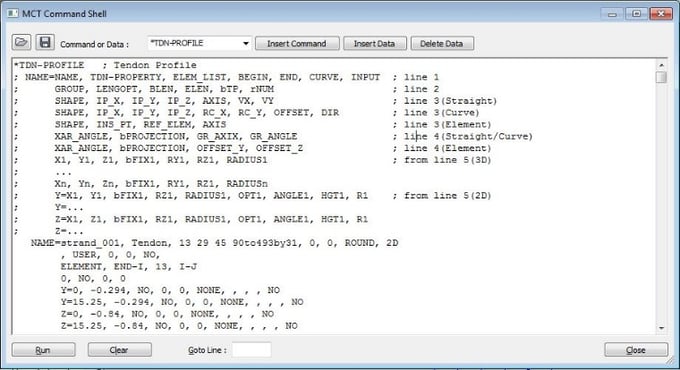 Figure 12. Modify Tendon Profile
Figure 12. Modify Tendon Profile
4.6 Change Tendon Profile
The tendon properties assigned to a number of tendon profiles can be changed at the once. This would save enough time in modifying a huge number of tendons. Especially in case of improving the Debonded length of pretension type of tendon. In this way, we can attain Stress Control.
At the beam’s ends, the prestressing strands can result in unwanted internal stresses and cracking. By proper curtailment of the debonding tubes, the total effective prestressing force and its eccentricity can be varied over the length of the beam with their maximum values in the mid-span region. After defining the tendon length for complete length of the span, the program would automatically take the effect of bonded part according to the value provided in the debonded length at Start & End.
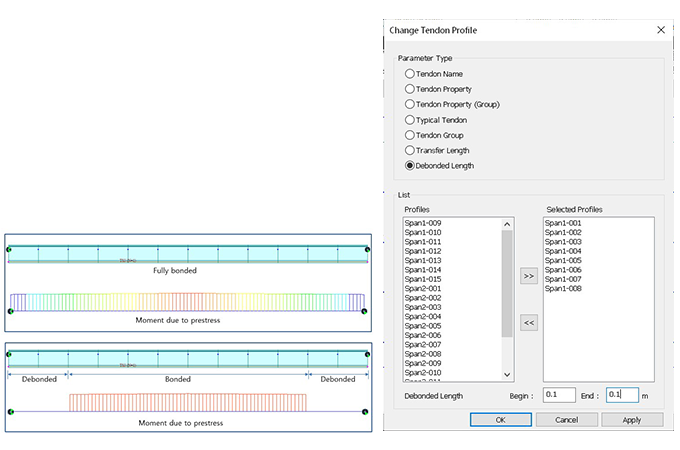 Figure 13. Change Tendon Profile
Figure 13. Change Tendon Profile
5. Parametric Design Options
In any PSC bridge design, whether it is balance cantilever or continuous structure bridge, a great amount of time is spent on the iteration of tendon profile and tendon numbers to satisfy the design for a given bridge span or section. However, modifying the prestressing tendon is NOT-the-ONLY solution. This takes us to the wide range of variables in the design of a prestressed girder.
- Number of Tendons
- Profile of each Tendon
- Change in Section Dimensions
- Additional Reinforcements
5.1 Number of Tendons
By considering the change in the number of tendons to satisfy the demand, one may obtain an economical or a feasible solution. In case the requirement of reinforcement is higher, and at the same time, the section size is such that many interferences or clash detection have occurred, then increasing the number of tendons seems to be a suitable option.
5.2 Profile of Each Tendon
There has been quiet a debate on how a program should provide the optimized tendon profile. This is because optimizing a tendon profile involves parameters such as an engineering decision of whether to input more reinforcements or tendons and check the clashing at the same time, change in stiffness of the section due to duct location, or change the cross-section of the girder altogether, and so on, making it impossible to attain the “correct” solution.
Mostly, in the near future, better sophistication can be achieved by our developers to make the impossible as possible. Till then the MCT command can be utilized at its best for a parametric analysis.
5.3 Change in Section Dimension
A possibility of increasing the section depth, in case the architect permits, may become a solution to achieve desired flexural capacity instead of change in tendons. Apart from the size, one can substitute different shapes (as these are precast) for an economical and architecturally pleasant at the same time.
5.4 Additional Reinforcements
One can achieve to satisfy the flexural capacity of a PSC girder by adding more reinforcements. In midas Civil with addition of each rebar data, the stiffness of the girder can be modified for a practical analysis & design result.
6. Conclusion
The tendon profile in the design of a PSC girder is based on several factors such as the types of Prestressing, effective prestress after losses, number of tendons, arrangement of tendons, the addition of reinforcement, and change in section stiffness due to prestress and rebars. The possible method of parametric design is mostly based on the site requirements. Also, the cost of the structure is determined to conclude with the design of a prestress girder bridge.
In the end, it is the Engineering judgement that pays off. We have often heard names of Engineers involved in the design of a bridge rather than a machine. Then again, it is a great way of involving a partner like midas Civil to achieve successful commencement of a Bridge Project.
9. References
 Get Started midas Civil
Get Started midas Civil
 Featured blog of this week
Featured blog of this week






